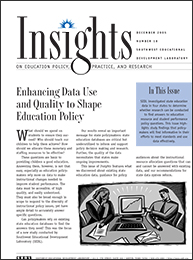At A Glance
Efforts to base education policy and practice on reliable data are increasing. The heightened need for answers about the allocation of resources to improve student performance have prompted policymakers and researchers to ask, Can existing state education data support research that will provide this information?
This edition of Insights on Education Policy, Practice, and Research summarizes a recent SEDL study that explored what can be learned from state education data systems about the allocation of instructional resources and how this may impact student achievement. Specifically, this brief gives policymakers a clearer picture of the capacity and quality of the state data to answer questions about instructional spending and teacher quality based on four states in the SEDL region.
Instructional resource data is available and accessible in separate state databases.
- Detailed instructional expenditures for school districts are in a fiscal database.
- Average staff salary data are in a fiscal database and individual salary data in a staffing database.
- Teacher quality data, e.g., teacher experience and education, and teacher characteristic data, e.g., position and race/ethnicity, are in a staffing database.
- Teacher certification data are in a distinct database not generally linked to other teacher data.
- School and district databases with demographics and other descriptive data
- are often on state agency Web sites.
- Student databases include characteristics, program participation, and performance measures for each student and are highly confidential.
State data is highly useful for policy making and research.
- See how instructional dollars are spent and how the spending varies across districts.
- Find answers to questions about teacher quality, its relationship to teacher salary, and its impact on student performance.
- Determine what staff resources comprise each school and how those resources differ across schools with varying levels of student performance.
Ongoing reform of state education data systems is needed.
Collect new and improved data, including school expenditures; more accurate staff years of experience; teacher certification alignment to subject and grade being taught; and professional development costs, content, and quality.
- Link data on individual teachers to their students.
- Combine fiscal, staff, school, and student databases.
- Improve data access, including clear procedures for data requests and detailed
- data documentation.
Next Page: References and Credits

